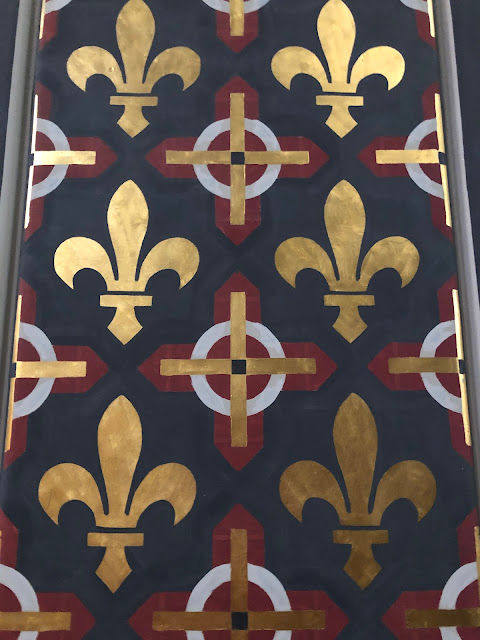The cathedral was inspired by the Votivkirche in Vienna, Austria (constructed in the 1870's). The architect selected for the project in Montana was A.O. von Herbulis (1861 - 1928), a son of the Austro-Hungarian Empire who later emigrated to Washington, D.C. In his youth he lived in Vienna for his studies and was inspired by the Austrian model of Gothic Revival. The cornerstone in Montana was laid in 1908 and the first Mass was celebrated in 1914. The cathedral is perched in a perfect location, on a highpoint overlooking the city, rightfully crowning Helena with is tall steeples, resembling the gates of the heavenly city.
The cathedral windows are impressive, made by F.X. Zettler in Munich, Germany and restored in 2007-2010. There is a most fitting rose window and other oversized windows that depict images such as St. Helena the patroness, the Emperor Constantine, Christopher Columbus, Adam and Eve (with Satan as a blue serpent), Moses and the 10 Commandments, St. Patrick, the Sacrifice of Abraham, the Sacraments, and more.
The cathedral has oak choir stalls fit for canons, a rare sight in North America, seen below. Imagining a plainchant schola here brings to mind the words of Cardinal Ratzinger when he wrote that sacred music "elevates the spirit precisely by wedding it to the senses, and it elevates the senses by uniting them with the spirit (The Spirit of the Liturgy, 150). Indeed, celebrating the liturgy involves the whole person, body and soul, as does sacred architecture.
In 1914 the contract for the interior furnishings was awarded to the Dubuque Altar Company in Iowa. In this was included the pews, confessionals, the Bishop's throne, pulpit, choir stalls, vestment cases for the sacristy, the organ ceiling, and casing. The finest wood was used, quarter-sawed, hand carved, white oak. These items were donated by one benefactor, Mr. T. C. Powers, a Helena businessman. The cost was between $15,000-$20,000 and the items were shipped on 4 rail cars.
On Easter Sunday 1916 the announcement was made that the heirs of the Cruse estate gave $15,000 for the creation of the main altar and that Miss Sarah E. Power would donate a costly set of Stations of the Cross while Mrs. T.C. Power would present a beautiful set of white vestments to the sacristy for the use of the Bishop and priests. The main altar was of white Carrara marble, artistically designed and in harmony with the architecture of the Cathedral itself. The Stations were made of the finest Italian marble, at a cost of $5,000. Bishop Carrol approved of the drawings and plans that were submitted to him by a representative of the Daprato company of Chicago. By Christmas all was ready and in place.
The present main altar bears mute witness of past renovations. The first renovations came after the cathedral sustained damage during a series of earthquakes in 1935 which required extensive repairs. During those quakes the large white marble cross (see black and white photo below) fell and was destroyed, along with the altar stairs (the three-step predella). Additional renovations were realized in 1958 and in 1983. The original altar was obviously chopped up in the 1950's, with the elaborate retable missing since that time.
Photos of the original altar that was installed in 1916, an incredible work of inestimable art, can be seen here when it was featured in the Daprato Statuary Company catalogue (Creations in Ecclesiastical Art, p. 86).
The catalogue entry reads: "With all the loveliness of snow white marble masterfully executed, this altar may easily claim rare distinction. It is a creation of undoubted artistic merit and however viewed presents an imposing picture. Specially designed and executed by Daprato Statuary Company, Chicago, New York, Pietrasanta, Italy."
This is what the original altar looked like (notice the golden candlesticks have survived and are still seen today):
The Daprato catalogue continues: "If ever nature intended that of her products some should reign as kings of glory and others rank as lesser lights, according to their merit, marble indeed belongs to earth's finest nobility. Classed as the most beautiful among the stones for artistic embellishment, marble also offers a permanence that promises to last as long as time itself" (Creations of Ecclesiastical Art, p. 6).
Daprato produced some of the finest marble altars in North America. Supremely beautiful in itself, marble offers a permanence and usefulness that will last until the end of the world. It requires flawless artistry of execution. The beautiful marble altar made for the cathedral was a gem of artistic magnificence, made of dazzling white Carrara from studios located in the very heart of the Carrara marble district in Italy. Daprato was for decades in a position to select the choicest blocks of marble, for the best price, with their pick of the finest artists of recognized talent.

























